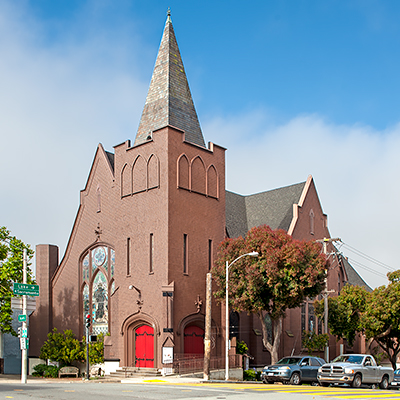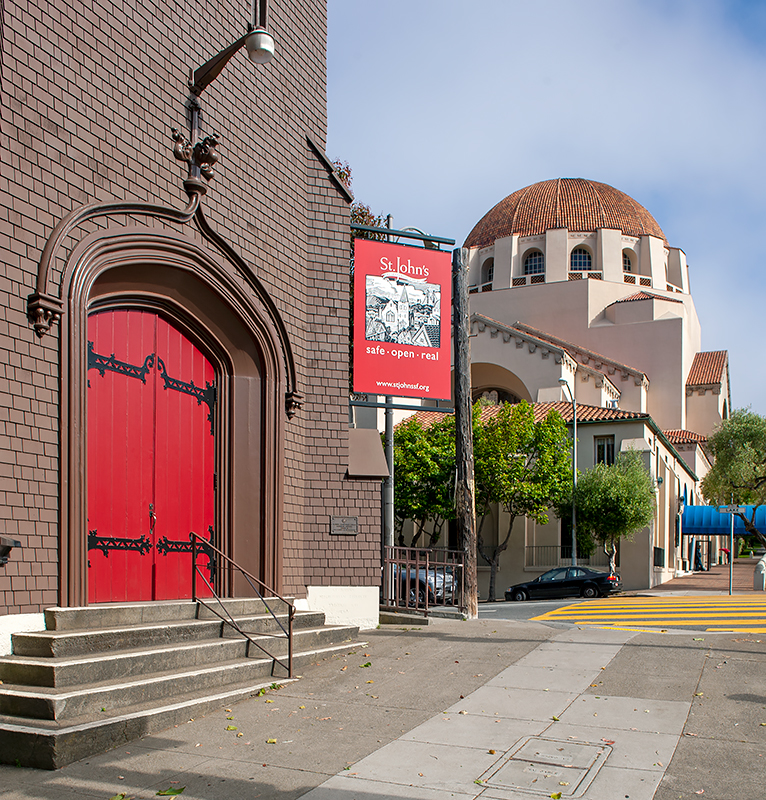San Francisco Landmarks
Saint John's Presbyterian Church
25 Lake Street
Built 1905
Christian architecture has always been tied to prevalent religious theory.
With the advent of humanism and self-determination in the 17th and 18th centuries, the control and influence of the church began to take a secondary role to political power. As the church relinquished its absolute political control, so did its artistic dictatorship come to an end. No longer were all churches created following a standard format. Rather, religious design became more responsive to individual and cultural distinctions.
By the end of the 19th Century, this individualistic approach to the artistic interpretation of religious theory resulted in churches which combined a multitude of styles taken from many cultures and societies. This design movement was known as eclecticism.
When Saint John's was designed, architects George Dodge and J. Walter Dolliver were responding to just these concepts.
In 1905-06, a popular design motif was the shingle style, evocative of rustic simplicity and directness. The style used broad sweeping gables, with deep overhangs and an over-all shingling to express the romantic vision of life so popular with the late Victorians and Edwardians. This style is important in the development of religious architecture in that it is a direct response to the humanization of scale and integration of nature that has consistently been a trend in design all along the western coastline of the United States.
The clean, Puritan lines of the design derive from English architect Christopher Wren. The tower's placement in the front of the structure reinforces the symbolic use of the church as a community gathering place and political hub of the community.
Adapted from City Planning Commission Resolution 7473 dated April 8, 1976.

The formal organization of Saint John's Presbyterian Church took place on March 6, 1870, when sixty-one charter members met at Pacific Hall, at Bush and Kearny Streets, to establish a new Presbyterian congregation in the City.
Dr. William Anderson Scott was named pastor and the congregation by purchased Old Saint James Episcopal Church, located at Post Street near Mason Street. The first services were held at the new church on Sunday, March 27, 1870.
Prior to his appointment as pastor, Dr. Scott had been hung in effigy twice and run out of town once.
Dr. Scott and his family first arrived in San Francisco in 1854 by clipper ship from New Orleans. He began preaching in the Music Hall at Montgomery and Bush Streets, and quickly raised money to build Calvary Presbyterian Church. On October 5, 1856, he was hanged in effigy from a lamppost at Bush and Montgomery because of his opposition to Committee of Vigilance.
On September 22, 1861, Dr. Scott was once again hanged in effigy, this time outside his church for including Jefferson Davis, President of the Southern Confederacy, in his public prayers. The doctor and his family left the city promptly, and went by steamer to Panama, then to England, Paris and back to England before taking a pastorate in New York City.
Dr. Scott returned to San Francisco in 1868 hoping to become pastor of Calvary Presbyterian once again but ending up at Saint John's where he remained as pastor until his death in 1885. (In 1880, Dr. Scott married Robert Louis Stevenson and Fannie Osborne in his study.)
In 1888, the congregation moved from their downtown site to a new building located at California and Octavia Streets.
At the beginning of the 20th century, the decided to build a new home, and chose the site of the present church at Arguello and Lake Streets, close to the Presidio of San Francisco, surrounded by sand dunes, enshrouded by fog. Ground was broken on April 25, 1905. The first service was on Easter Sunday, April 15, 1906.
Three days the church was shaken by the great earthquake. Damage was severe. The chimney crashed into the rear of the building, damaging much of the furniture and the organ. Some of the stained glass windows were loosened and fell into the street. But the dedication of the members to the future of their church did not flag; services were held in the members' homes.
On April 28, 1907, repairs were completed and the church was rededicated.
The history of the church in its present location parallels the development of the Richmond District. Rows and rows of homes replaced the sand dunes; the congregation grew in numbers.
Attendance at Sunday School swelled with children from the Maria Kip orphanage at Seventh Avenue and Lake Street and the San Francisco Protestant Orphanage at Fourteenth Avenue and Lake Street. The church was always responsive to the needs of the community. After the fire and earthquake, the congregation provided food and shelter to refugees encamped in the neighborhood and in Golden Gate Park. During the Depression, the congregation provided food to the unemployed and helped them find jobs. In World Wars I and II, the church sponsored programs for soldiers stationed at the Presidio. The church women knitted socks, sweaters and afghans. They made quilts and bandages for the American Red Cross.
Adapted from City Planning Commission Resolution 7473 dated April 8, 1976.

Saint John's Presbyterian Church is also National Register Listing #95001555.

